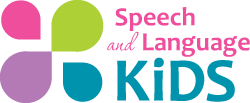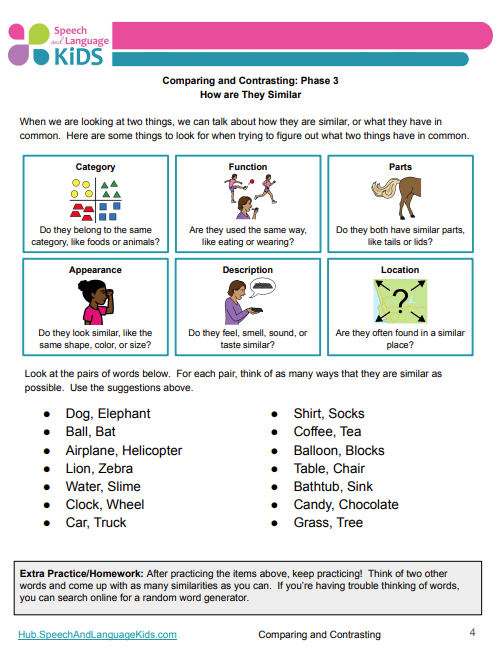Compare and Contrast | Speech Therapy Activities for Finding Similarities and Differences
Vocabulary delays are hard to treat.
We can’t possibly teach a child every word he’ll ever need to know.
That’s why The SLK Curriculum teaches word-learning strategies.
These strategies teach children and teens ABOUT vocabulary and provide them with the tools to be able to learn words more quickly and easily.
On this page, we’ll show you how to teach a child to compare and contrast different words and concepts in order to boost their vocabulary skills. We’ll show you our favorite speech therapy activities for improving their ability to find similarities and differences, thus expanding their semantic understanding.
What are “Comparing and Contrasting” Skills?
For this skill, we will help children identify when things are the same or different. Then, we’ll help them
describe how two items are similar or different by comparing and contrasting aspects about those items.
Sample Therapy Goal for Comparing and Contrasting:
When presented with two stories, experiences, or perspectives, Client will tell two ways that they are similar and two ways that they are different on 4 of 5 observed opportunities.
Speech Therapy Activities for Comparing and Contrasting:
Here’s how we would break this skill down into a step-by-step plan for teaching a child to compare and contrast. Keep in mind that younger children may not need to go through all six of these phases.
- Same or Different (Identical): When shown two identical images, Client will identify if two pictures are the same or different.
- Same or Different (Not Identical): When shown two images that represent the same thing but look different (such as two pictures of different dogs), Client will identify if the two pictures represent the same concept or different concepts.
- How are they Similar: When two objects are named, Client will name at least two ways that they are similar when given possible similarities, such as “category, function, parts, appearance,” etc.
- Comparing and Contrasting Objects: When two objects are named, Client will name two ways that they are similar and two ways that they are different.
- Distinguishing Shades of Meaning: When given two words with similar meanings (such as “dirty” and “filthy”), Client will tell how the meanings are similar and how they are different.
- Comparing and Contrasting Stories, Experiences, and Perspectives: When presented with two stories, experiences, or perspectives, Client will tell two ways that they are similar and two ways that they are different.
A Structured Curriculum for Teaching Vocabulary Skills:
Still wasting time cobbling together random therapy activities?
Ever feel like your sessions aren’t quite moving the needle for your vocabulary clients?
Don’t worry, I felt that way, too!
That’s why I created a systematic approach to vocabulary that starts with teaching individual words…
…but grows into teaching word-learning skills that ACTUALLY help children make faster progress in expanding their vocabularies.
Grab our Vocabulary Curriculum (and all of our other Curriculums) Inside the SLK Curriculum Platform:

About the Author: Carrie Clark, MA CCC-SLP
Hi, I’m Carrie! I’m a speech-language pathologist from Columbia, Missouri, USA. I’ve worked with children and teenagers of all ages in schools, preschools, and even my own private practice. I love digging through the research on speech and language topics and breaking it down into step-by-step plans for my followers. I graduated from Truman State University in Kirksville, MO with a masters degree in Communication Disorders.
Fun Fact: I have been to the ASHA Convention several times, including twice in Boston. Did you see me? My booth in 2023 was right next to the Peachie Speechie booth with all of her fun t-shirts. I had a blast getting to meet so many of my followers face-to-face! Working online makes it difficult to feel connected to my customers so it was nice to see all of you!
Connect with Me:




Fantastic breakdown, Carrie! Your step-by-step plan makes teaching “Comparing and Contrasting” skills a breeze. Curious, any anecdotes from your private practice that really highlight the impact of these lessons?
I discovered that these techniques were quite successful in assisting my daughter in growing her vocabulary, encouraging critical thinking, and gaining a deeper comprehension of parallels and contrasts.
What are the fundamental components of “Comparing and Contrasting” skills as applied to children’s education?
Hey there! Can you tell me more about what you’re asking? I’m not sure exactly what you’re looking for.
There are no words to describe how much I appreciate all the time and insightful information you have given me. Your reliability as an inspiration is greatly appreciated.